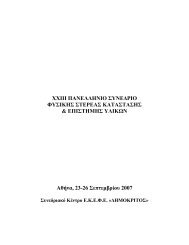Salicylaldoxime (H2salox) in iron(III) carboxylate chemistry ...
Salicylaldoxime (H2salox) in iron(III) carboxylate chemistry ...
Salicylaldoxime (H2salox) in iron(III) carboxylate chemistry ...
You also want an ePaper? Increase the reach of your titles
YUMPU automatically turns print PDFs into web optimized ePapers that Google loves.
C.P. Raptopoulou et al. / Polyhedron 24 (2005) 711–721 719Fig. 7. EPR spectrum from a solid powder sample of 1 and 2 at 4.2 K.EPR conditions: microwave frequency, 9.41 GHz; microwave power,50 mW; modulation amplitude 10 G pp .Fig. 8. EPR spectrum from 1 and 2 <strong>in</strong> acetone glass at 4.2 K. EPRconditions: microwave frequency, 9.41 GHz; microwave power, 2 mW;modulation amplitude 10 G pp .isolated S = 1/2 systems. We attribute this behaviour to<strong>in</strong>termolecular <strong>in</strong>teractions present <strong>in</strong> the solid state.This is supported by the crystal structure reveal<strong>in</strong>g <strong>in</strong>termolecular<strong>in</strong>teractions between neighbour<strong>in</strong>g trimers.We note that the low temperature magnetic susceptibilitydata for complex 2 cannot be reproduced with isolatedtrimers and the EPR spectra support weak<strong>in</strong>termolecular <strong>in</strong>teractions. For compound 1 the <strong>in</strong>termolecular<strong>in</strong>teractions appear to be weak enough, sothey do not affect the magnetic susceptibility data. However,weak dipolar <strong>in</strong>teractions may substantially affectthe EPR spectra. For <strong>in</strong>stance a weak dipolar <strong>in</strong>teractionbetween two S = 1/2 systems of the order of0.05 cm 1 can be hardly discernible <strong>in</strong> bulk magneticsusceptibility measurements, but it will critically affectthe EPR measurements lead<strong>in</strong>g to spectra extend<strong>in</strong>g <strong>in</strong>a large magnetic field region.In order to elim<strong>in</strong>ate the solid-state effects, we studiedby EPR both compounds <strong>in</strong> an acetone glass, a weaklycoord<strong>in</strong>at<strong>in</strong>g solvent. The 4.2 K spectra are shown <strong>in</strong>Fig. 8. A strong signal is observed at g 2.0 for bothcompounds. The signal is characterized by a symmetricderivative feature with a l<strong>in</strong>e-shape which is better describedby a Lorenztian curve. The temperature dependenceof this signal <strong>in</strong>dicates that it arises from aground state. The dependence of the signal on microwavepower and the l<strong>in</strong>e-shape argues aga<strong>in</strong>st a free radicalspecies. Further, it is improbable that this signalarises from monomeric Fe <strong>III</strong> (S = 5/2) species result<strong>in</strong>gfrom decomposition of the compound upon solvation<strong>in</strong> acetone. Usually such species gives rise to signals athigher g-values (for <strong>in</strong>stance at g 4.3) as a result ofzero-field splitt<strong>in</strong>g effects. No such signals are observed<strong>in</strong> the present case. A monomeric Fe <strong>III</strong> (S = 1/2) low sp<strong>in</strong>species can be also excluded because <strong>in</strong> this case fairlyanisotropic signals are expected.On the other hand, it is reasonable to assume that theEPR signals of Fig. 8 arise from the S = 1/2 ground stateof isolated trimers <strong>in</strong> both compounds. The symmetricl<strong>in</strong>e-shape of the signals suggests an isotropic system.This is <strong>in</strong>deed expected from a trimer compris<strong>in</strong>g Fe <strong>III</strong>(S = 5/2) sites antiferromagnetically coupled with theisotropic Heisenberg–Dirac–van Vleck Hamiltonian asthe ma<strong>in</strong> <strong>in</strong>teraction. Although symmetric EPR l<strong>in</strong>esare expected this is rarely met <strong>in</strong> tr<strong>in</strong>uclear complexesof Fe <strong>III</strong> (S = 5/2) or Cr <strong>III</strong> (S = 3/2) [39,48–53]. Usually,<strong>in</strong> such systems, non-Heisenberg <strong>in</strong>teractions such asantisymmetric exchange and/or s<strong>in</strong>gle-ion zero-fieldsplitt<strong>in</strong>g terms result <strong>in</strong> an anisotropic S = 1/2 groundstate. Due to the anisotropy, broad EPR signals are observedextend<strong>in</strong>g to high field values with g 2.0. In thepresent case the signal is symmetric and conf<strong>in</strong>ed at theg 2.0 region <strong>in</strong>dicat<strong>in</strong>g that the contribution of theseterms is negligible. From this po<strong>in</strong>t of view compounds1 and 2 are rare cases of triferric complexes where theanticipated S = 1/2 EPR signals are <strong>in</strong>deed observed.4. ConclusionsAs part of our cont<strong>in</strong>u<strong>in</strong>g efforts to synthesize polynuclear<strong>iron</strong>(<strong>III</strong>) complexes with novel magnetic properties,we have reacted H 2 salox with <strong>iron</strong>(<strong>III</strong>) <strong>in</strong> thepresence of <strong>carboxylate</strong>s. The two new neutral <strong>iron</strong>(<strong>III</strong>)complexes, [Fe 3 (l 3 -O)(O 2 CPh) 5 (salox)L 1 L 2 ] (L 1 =L 2 =MeOH (1), L 1 = EtOH, L 2 =H 2 O(2)) derived, conta<strong>in</strong>the [Fe 3 O] 7+ core found <strong>in</strong> Ôbasic <strong>iron</strong> <strong>carboxylate</strong>sÕ. Incomplexes 1 and 2 however two <strong>iron</strong> atoms are <strong>in</strong> anO 6 coord<strong>in</strong>ation env<strong>iron</strong>ment whereas the third is found<strong>in</strong> an O 5 N one. A detailed characterization of complexes1 and 2 <strong>in</strong>clud<strong>in</strong>g spectroscopic and magnetic studieshas been carried out. The nonequivalence of the
















